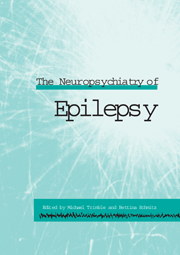Book contents
- Frontmatter
- Contents
- List of contributors
- Part I Background
- Part II Clinical aspects
- Part III Cognitive aspects
- Part IV Nonepileptic attacks
- 13 Epilepsy, dissociation and nonepileptic seizures
- 14 Psychobiology of psychogenic pseudoseizures
- 15 Epilepsy and panic disorder
- Part V Treatment complications
- Part VI Treatment
- Index
15 - Epilepsy and panic disorder
Published online by Cambridge University Press: 05 October 2010
- Frontmatter
- Contents
- List of contributors
- Part I Background
- Part II Clinical aspects
- Part III Cognitive aspects
- Part IV Nonepileptic attacks
- 13 Epilepsy, dissociation and nonepileptic seizures
- 14 Psychobiology of psychogenic pseudoseizures
- 15 Epilepsy and panic disorder
- Part V Treatment complications
- Part VI Treatment
- Index
Summary
Introduction
Epilepsy is a neurological condition associated with well-defined abnormalities of brain electroencephalographic (EEG) activity. It is generally treated with antiepileptic agents and occasionally with resective neurosurgery. Panic disorder (PD) is a psychiatric condition mostly treated with antidepressant medication and cognitive – behaviour therapy (CBT). Why then should be conditions in any way be considered together in the same chapter? This paper will initially point out clinical similarities and differences and will then discuss the question of whether there are any pathophysiological similarities between the two conditions.
Epilepsy
Epilepsy is a complex condition characterized by recurrent episodes of paroxysmal disturbance of normal brain functioning. For a secure diagnosis of epilepsy to be made there needs to be evidence that these paroxysms of disturbance involve both disruptions of ongoing behaviour and abnormalities of brain electroencephalographic (EEG) activity recognized as epileptiform.
The clinical manifestations of epilepsy depend on the site of origin, or focus of the seizure, the pattern, manner and extent of propagation of epileptiform electrical activity through the brain and the aetiology of the epilepsy. From the point of view of the person with epilepsy, the subjective experience of repeated seizures is generally relatively similar, or sterotyped, although the actual nature of the experience is highly variable between individuals. Hence some may experience hardly any awareness of a seizure, even if they collapse to the ground unconscious and proceed to suffer a sustained tonic-clonic convulsion.
- Type
- Chapter
- Information
- The Neuropsychiatry of Epilepsy , pp. 226 - 238Publisher: Cambridge University PressPrint publication year: 2002

